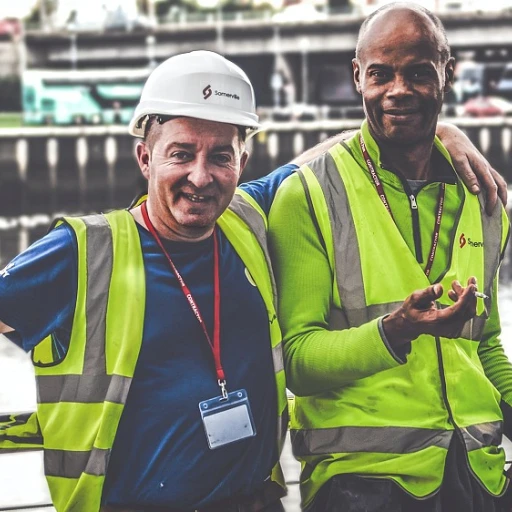Understanding the Essence of High-Performance Culture
The Heartbeat of Company Culture
Building a culture of high performance is about creating an environment where employees feel driven and supported to be their very best at work every single day. This isn't some fluff. It's about valuing your people—their ideas, their work ethic, and their commitment to the company's goals—as much as any other business asset. Let's think about company culture like chocolate. Everyone loves chocolate, but not everyone loves the same type. A high-performance culture is tailored to fit the unique tastes of your organization and its employees. It’s a blend of psychological safety, company values, and shared beliefs that underlines everything you do. Employees thrive in environments where they understand the company's goals and see how their actions directly contribute to those goals. It's a two-way street: when the company benefits, employees feel fulfilled and motivated, boosting personal and team performance even higher. Achieving such a culture involves more than just having policies written on paper. It's about turning those policies into everyday actions—from leaders cheering on their teams to providing continuous learning opportunities to help employee development. Through mentorship, honest feedback, and leadership that walks the talk, employees are engaged and ready to elevate not just their work life, but the entire business. It's essential that businesses recognize the important role emotional connections and shared company values play in driving a high performance culture. This isn't just a job; it’s a community where everyone, from top management to the newest hire, is pulling in the same direction. If you're keen on crafting a winning employee experience strategy that lights the way for building high performance, consider exploring more insights here.Role of CHRO in Cultivating High Performance
The CHRO as a Catalyst for High Performance
In any company, the Chief Human Resources Officer (CHRO) plays a pivotal role in shaping the performance culture. They aren't just the HR boss; they're the heartbeat of the company culture, ensuring that employees feel valued and motivated to achieve high performance. It's a bit like being the conductor of an orchestra, where every instrument, or in this case, every employee, needs to play in harmony to create a masterpiece.
Leadership and Alignment
Leadership is more than just a title; it's about aligning the goals of the organization with the aspirations of its employees. The CHRO helps bridge the gap between company goals and employee performance, ensuring that everyone is rowing in the same direction. This alignment doesn't happen overnight, but with consistent effort and clear communication, it can transform the way teams work together.
Building Trust and Psychological Safety
Trust is the foundation of any high-performing culture. Employees need to feel safe to express their ideas and take risks without fear of backlash. The CHRO is instrumental in fostering this environment by promoting company values that prioritize trust and psychological safety. When employees feel secure, they're more likely to contribute innovative ideas and take ownership of their work.
Continuous Learning and Development
In a high-performing culture, continuous learning isn't just encouraged; it's expected. The CHRO champions employee development by providing opportunities for growth and learning. This could be through training programs, workshops, or even mentorship opportunities. When employees see that their company is invested in their development, they're more likely to invest their best efforts in return.
Feedback and Open Communication
Feedback is a gift, and the CHRO ensures that it's given and received in a constructive manner. Regular feedback loops help employees understand their strengths and areas for improvement, fostering a culture of continuous improvement. Open communication channels, facilitated by the CHRO, also ensure that employees' voices are heard, making them feel valued and engaged in their work life.
For more insights on how the CHRO shapes company culture, check out this article.
Aligning Organizational Goals with Employee Performance
Aligning Company Goals with Employee Performance
When it comes to building a high-performance culture, aligning company goals with employee performance is like setting a GPS for success. Leaders play a vital role in this journey, ensuring everyone is on the same page and moving in the right direction. This alignment isn't just about hitting targets; it's about creating a work environment where employees feel motivated and engaged, knowing their efforts contribute to the bigger picture.
Imagine a company where every employee knows exactly how their work impacts the organization's success. This clarity not only boosts morale but also fosters a sense of ownership and responsibility. It's like each team member is a piece of a puzzle, and when they fit perfectly, the picture becomes clear. To achieve this, companies need to focus on several key areas:
- Clear Communication: Open and transparent communication channels are essential. Regular updates and feedback sessions help employees understand their roles and how they contribute to the company's goals. This transparency builds trust and strengthens the organizational culture.
- Setting SMART Goals: Goals should be Specific, Measurable, Achievable, Relevant, and Time-bound. This approach provides a clear roadmap for employees, making it easier to track progress and celebrate achievements.
- Performance Management Systems: Implementing effective performance management systems ensures that employees receive constructive feedback and have opportunities for growth and development. This system is a cornerstone of a high-performance culture, driving continuous improvement.
- Employee Development: Investing in employee development through training and learning opportunities shows that the company values its workforce. This commitment to growth not only enhances skills but also boosts employee engagement and loyalty.
Aligning goals with employee performance is a dynamic process that requires ongoing attention and adaptation. Companies that succeed in this endeavor create a thriving environment where employees are not just working for a paycheck but are genuinely invested in the company's success. By focusing on clear communication, setting SMART goals, and fostering employee development, businesses can build a culture that not only meets but exceeds expectations.
For more insights on creating a thriving company culture, check out our blog on crafting a winning company culture strategy.
Implementing Effective Performance Management Systems
Creating an Effective System for Employee Performance Management
A top-notch performance management system is just like the backbone of a high performance culture. It sets the ground for leaders to engage and elevate their teams, helping employees feel valued and motivated in their work. But how does one build such a system? Well, let's get rolling... First off, it's crucial to have company goals aligned with employee performance. Not only does this create direction, but it builds a sense of unity among employees. When staff understands how their roles contribute to the organization's success, their engagement shoots up. Leaders should make the goals clear, simple, and easy to track. Now for the nitty-gritty: feedback. It's the fuel for growth. Regular feedback loops between leaders and employees encourage continuous learning and development and they'll be instrumental when you're building high performance. Constructive feedback empowers employees to improve, while positive feedback boosts morale. An open communication channel provides psychological safety—a backbone of any strong company culture. Performance reviews, done the right way, will help in identifying areas for employee growth. But it's more than ticking a box—it's a chance for genuine connection, coaching, and understanding your team's needs. As you keep conversations ongoing, it transforms the "how I performed" narrative, to "how can I perform better?" On the tech side, don't be afraid to adopt digital tools for performance management. While not a silver bullet, these tools can streamline processes and simplify data handling. They keep everyone on the same page, fostering transparency and accountability. Remember, weaving company values into performance expectations fosters a sense of belonging. When employees resonate with your business principles, they are fired up to commit and excel. Combining these approaches enhances employee engagement and performance, ultimately crafting a thriving culture, high in spirit and results. If you're keen to explore how leaders can shape company culture, which impacts all this, check out our insights in how the CHRO shapes company culture. Trust me, it’s worth the read.Fostering Employee Engagement and Motivation
Creating a Motivating Work Environment
When it comes to high performance, a motivated employee is your secret weapon. But how do you make sure your teams are not just clocking in but truly engaged? It's all about the environment you create. Leaders play a pivotal role in fostering a company culture where employees feel valued and motivated to give their best. This means promoting open communication, recognizing achievements, and offering opportunities for growth.
Feedback and Continuous Learning
Feedback isn't just a one-time thing; it's a continuous process that helps employees grow. Regular, constructive feedback can significantly boost employee performance and engagement. It's not just about pointing out what's wrong but also about highlighting strengths and providing guidance for improvement. Coupled with opportunities for continuous learning, feedback becomes a powerful tool in building high performance. Encourage your teams to seek out new skills and knowledge, aligning with the company's goals and values.
Building Trust and Psychological Safety
Trust is the glue that holds a high-performing team together. When employees trust their leaders and colleagues, they feel safe to express ideas, take risks, and make mistakes. Creating a culture of psychological safety means promoting honesty and transparency, where employees feel their opinions matter. This trust will help drive engagement and innovation, contributing to a culture of high performance.
Aligning Personal and Organizational Goals
When personal ambitions align with the organization's objectives, magic happens. Employees who see a clear connection between their work and the company's success are more likely to be engaged and motivated. Leaders should work with employees to set personal goals that complement the organization's mission, creating a win-win situation for both parties.
Developing a high-performance culture isn't just a one-time effort; it's an ongoing commitment to your employees' growth and satisfaction. By focusing on these elements, companies can build an organizational culture that not only meets but exceeds performance expectations.
Overcoming Challenges in Developing a High-Performance Culture
Breaking Down Barriers to Success
Creating a high-performance culture isn't a walk in the park. It comes with its fair share of bumps and hurdles. One of the biggest challenges is resistance to change. Employees might feel comfortable with the current way of doing things, and any shift can be met with skepticism. To tackle this, it's crucial for company leaders to communicate the benefits of a performance culture clearly and consistently. This means sharing success stories and providing tangible examples of how changes will help both the organization and its employees thrive.
Building Trust and Psychological Safety
Trust is the backbone of any successful organization. Without it, employees may hesitate to take risks or voice their opinions. Encouraging open communication and feedback is vital. Leaders should foster an environment where employees feel safe to express their thoughts without fear of retribution. This psychological safety encourages innovation and helps in building high-performing teams. When employees know their voices are heard, their engagement and motivation naturally increase.
Aligning Company Values with Employee Goals
Another challenge is ensuring that company values align with employee goals. Misalignment can lead to confusion and frustration. It's essential for leaders to regularly revisit and communicate the company's core values, ensuring they resonate with the workforce. This alignment helps in creating a unified direction, making it easier for employees to understand how their roles contribute to the larger organizational goals.
Managing Continuous Learning and Development
In a culture high on performance, continuous learning and development are non-negotiable. Yet, providing consistent opportunities for growth can be a challenge, especially for businesses with limited resources. Companies need to invest in training programs that are accessible and relevant. Encouraging a mindset of continuous improvement will help employees stay updated and motivated to achieve their best.
Balancing Work-Life Integration
High-performing cultures often demand a lot from their employees, which can lead to burnout if not managed properly. Striking a balance between work and personal life is essential. Leaders should promote flexible work arrangements and emphasize the importance of taking time off. When employees feel their work-life balance is respected, they are more likely to remain committed and productive.
By addressing these challenges head-on, organizations can create a performance culture that not only meets business goals but also fosters a fulfilling work life for employees. This approach will help in developing a resilient and engaged workforce ready to tackle any challenges that come their way.








